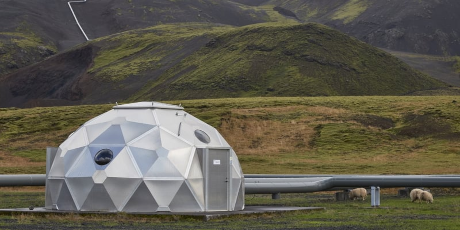7 things you should know about carbon capture 18 Apr 2023

Analysis: carbon capture can play a key role in meeting our energy and climate goals, but how does it work? - Dr. Elena Tsalaporta, School of Engineering and Environmental Research Institute, UCC
Carbon dioxide (CO2) is an essential component and nutrient for the planet, but, too much of it can cause irreparable damage to Earth's climate. In the last 200 years, human activities have raised the atmosphere's carbon dioxide content by 50%, causing temperatures to rise, the ocean to acidify, and extreme weather to become more frequent and common.
Carbon Capture, sometimes known as Carbon Capture, Utilisation and Storage (CCUS), is a way to reduce carbon emissions related to industrialisation, and prevent the emissions from continuing to harm the environment. CCUS consists of capturing carbon dioxide emissions from industrial processes, such as steel and cement production, power generation and from other sectors such as agriculture.
This carbon is then either used for the development of energy and materials (utilisation) or transported from where it was produced, via ship or in a pipeline, and stored deep underground in geological formations, thousands of feet below the surface (storage), reducing the human related carbon emissions in the air. Let’s explore 7 things you might not know about carbon capture.
How long has carbon capture been used for?
Carbon capture is not a new concept. It was initially proposed almost 100 years ago, back in 1938, and the first large scale project was introduced in 1972, in the Sharon Ridge oilfield in Texas. This project marked the beginning of this technology, as it confirmed that it was indeed feasible to remove carbon emissions.
Is carbon capture currently used?
Currently, there are 43 large-scale carbon capture and storage systems operating around the world. According to the International Energy Agency, more than 30 million tons of CO2 are captured globally from large scale carbon capture, utilisation, and storage facilities every year. This is roughly like taking 6 million cars off the roads.
Over 70 percent of the captured CO2 is captured in North America, while the US is currently leading this space, having the highest number of large-scale carbon capture and storage facilities in the world. According to the International Association of Oil and Gas Producers, there are around 70 existing or planned carbon capture projects in Europe, with Norway and the UK taking the lead. However, the scale of these projects is smaller compared to those in the US.
How can carbon dioxide retrieved from carbon capture be reused?
The recycling of the captured carbon dioxide actually converts it from a pollutant into a resource. For example, Coca-Cola is already using recycled carbon dioxide emissions to produce their popular beverages. Recycled CO2 can also be converted into green cement, insulation foam and fertiliser and fuel, or it can be fed into algae in order to produce carbon fibre or to revive oyster reefs.
Can carbon dioxide can be safely stored underground?
Nature knows best. The underground geological storage of carbon dioxide has been a occurring for hundreds of millions of years, therefore CO2 can safely and permanently be stored in certain rock formations.
Why isn't carbon capture being used everywhere already?
Fundamentally, it all comes down to money. From a financial perspective, it is cheaper to release carbon dioxide to the atmosphere than to remove it. From an environmental perspective though, there is a grave need for climate change to be mitigated. So, the reality is that there is a conflict of interest here. To change that reality, there must be economic costs implemented to releasing carbon dioxide into the atmosphere, or in other words, a strict carbon tax system.
While scientists and researchers are working to improve carbon capture technologies in terms of efficiency and costs, these costs will never be zero. Hence, even the best carbon capture technology will be useless if the world is not willing to put a high price on carbon dioxide.
Is carbon capture a permission to emit more?
The quick answer is no. While CCUS is an effective way to remove and reuse carbon emissions that are already circulating in the air, it is not a permission to keep emitting CO2; it is rather a bridge technology that will help us halt the effect of climate change before moving to a new energy era. Moreover, carbon capture does not change the industrial practices that continue to pollute by emitting high levels of CO2; carbon capture can ultimately only do so much.
The biggest benefit of CCUS is not that we can continue with our old habits; with CCUS, we are in fact buying time by allowing carbon dioxide to be reused in various ways, until we will implement novel sustainable industrialisation practices that will not harm the environment.
What’s a better investment: renewables or carbon capture?
In the fight against climate change, there is no magic bullet. CCUS and renewables have both advantages and disadvantages, therefore the question is not which solution is the best; the question is how we can use them both in order to achieve our environmental goals. Retrofitting existing facilities with CCUS and using renewables is a more effective solution than relying only on one of them. This is not a competition, this is a synergy; many hands make light work.